Known as a living mulch, Grevillea nudiflora can be used as a great tool in gardens to suppress weeds and stabilise the soil. Requiring little maintenance and being one of the easiest grevilleas to grow, this bushy native has become a popular choice for many beginners and expert growers alike.
With dense dark green foliage, curved shapely leaves, and radiant red flowers that curve with a yellow hue, this plant can add beautiful lusciousness to any garden.
More...
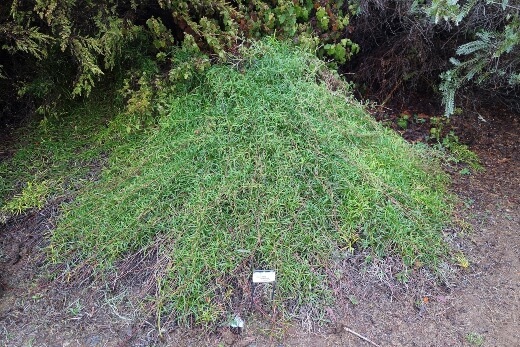
Source: commons.wikimedia.org
Genus: | Grevillea |
|---|---|
Species: | G. nudiflora |
Family: | Proteaceae |
Common Names: | Grevillea Ground Cover, Grevillea Ground Cover Plant |
Location: | Outdoors |
Type: | Ground Cover Shrub / Cascading Plant |
Growth: | 0.3-1.8 metres high / 1.5 to 5 metres wide |
Sun requirements: | Full sun to partial shade |
Foliage Colour: | Green |
Flower Colour: | Red |
Flowering: | Winter to Spring |
Maintenance level: | Low |
Features of Grevillea nudiflora
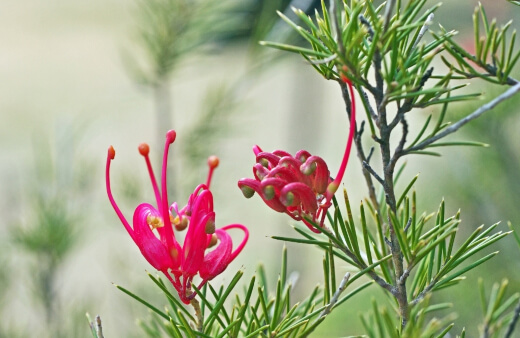
Also commonly referred to as Grevillea nudiflora ground cover, this shrub originates from South Western Australia where it thrives in a temperate, sunny environment that provides a dense and varied growth habitat.
Being a part of the Proteaceae family and inheriting hardy characteristics from its grevillea shrub counterparts, the Grevillea nudiflora can make a very strong ground cover plant in your garden or can be used as a cascading plant.
This fast-growing prostrate shrub can develop into a variety of sizes depending on the growing conditions. On average it can reach a height of between 0.3 to 1.8 metres and a width or spread of between 1.5 to 5 metres.
Frequently used in households as cascading plants over a retaining wall or in large hanging baskets, this native shrub can also be used in rockeries and looks fantastic planted alongside other Australian native plants in the garden.
How to Grow Grevillea nudiflora

Being a very adaptable plant overall, the Grevillea nudiflora shrub can grow and thrive in many different situations. From woodlands to heath, coastal environments (making it suitable for coastal gardening) to inland, this plant isn't too fussy as long as a few basic conditions are met.
They tend to cover a large amount of ground so they look best with room to spread and are one of the few low growing varieties of Grevillea.
Growing Grevillea nudiflora from Seed
Seeds can be sown throughout most of the year in Australia but sowing during the more temperate months of spring or autumn is recommended. Sowing during the hottest or coldest periods of the year is not ideal.
A healthy temperature range for seed germination is between 18 to 22°C. The larger seeds of the Grevillea nudiflora can be carefully nicked with a sharp knife or scissors to expose the embryo before sowing.
This can assist with moisture absorption to accelerate germination. This is optional.
Here is how you can grow Grevillea ground cover plants using seeds:
- Soak your seeds in warm water overnight before sowing.
- Use a growing tray, pots or your garden bed and sow your seeds roughly 3 millimetres deep into your soil mix. Avoid placing the seeds too deep in the soil.
- Place your container or containers in a shady location and avoid letting the soil dry out too much.
- Your containers or garden soil should be well-draining and allow the soil to remain moist between waterings.
- Water the soil to keep it damp but not wet.
- Germination can start within 21 to 60 days.
Don’t be too hasty and throw your seeds out if they have not germinated in that time frame. Native seeds can be fussy and lay dormant for some time.
They are known to wait for conditions to be similar to those of their native habitats before they sprout successfully so give them some time and you should have healthy seeds to plant.
How to Propagate Grevillea nudiflora
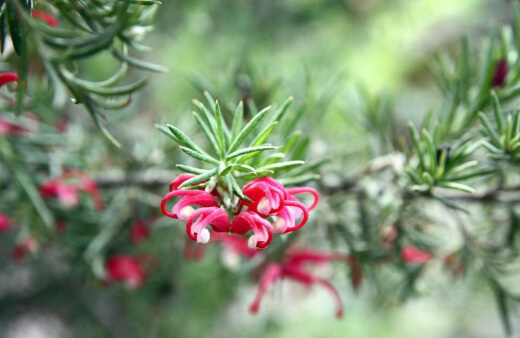
The Grevillea nudiflora is most successfully propagated using cuttings from a healthy donor plant. After the flowering season, fresh and healthy growth should start to appear.
Propagating Using Stem Cuttings
Here is how you can propagate the Grevillea nudiflora shrub using cuttings:
- Use sharp scissors or a knife and cut about 10 centimetres from a healthy, disease-free stem.
- You can trim away the leaves towards the bottom of your cutting and also remove any young flowers or shoots.
- Submerge the stem of the cutting into a little rooting hormone.
- Place the cutting into your potting mix in a well-draining container.
(See our potting mix buying guide here.) - Checking when water is needed, you can mist or lightly water the plant to keep the soil moist.
- Place your planted cutting in a warm location with bright, indirect light. Try to avoid harsh, direct sunlight.
Give your cutting about 4 to 8 weeks to start developing its roots and establishing itself in its new home. Once you have seen new growth, leave your cutting for another 3 to 4 months to fully develop and be as healthy as possible before transplanting it to its forever home.
This will avoid transplant shock and give your Grevillea nudiflora the best shot at survival. It is recommended to grow a few cuttings at the same time to increase your chances of success.
Planting Grevillea nudiflora
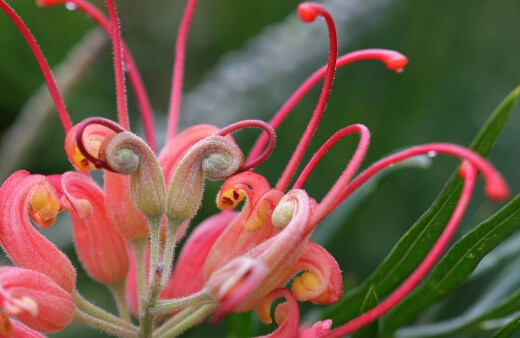
Now that you have your sprouted seeds or your healthy, developed cutting, you can place your new plant baby in its forever home. Planting during early Spring or Autumn is considered the best time for this shrub.
Being a spreading ground cover shrub, it is almost always planted outdoors in and around the garden. These plants grow to be very dense and are therefore great to ward off weeds and other unwanted plants.
Another great benefit of the inherent lusciousness of the shrub is that it can be a haven for native birds and insects that depend on the shrub for food and habitat.
Due to their vigorous root systems, it is recommended to plant the shrub away from any drains or sewage lines.
Here is what your Grevillea nudiflora will need when considering planting:
Best Soil for Grevillea nudiflora
This tough native can tolerate most types of soil and is also not shy of acidic soils. However, they are known to grow best in sandy to loamy and well-draining soils.
Sunlight Needs
This plant can thrive in full sun to partial shade so be sure to pick out a good location in your garden that receives enough light. This will also ensure that the humidity and temperature levels are adequate for the native shrub.
How to Plant Grevillea nudiflora
Now that you have picked out the perfect spot in your garden, follow these simple steps to plant your Grevillea nudiflora shrub:
- Dig your planting hole twice as big as the root-ball of your shrub.
- Gently remove the plant from its current container, being sure to disturb the roots as little as possible.
- Position the plant snuggly in the hole and backfill with your soil mix.
- Gently firm the soil with your hands being careful not to overly compact it.
- Water well in the first couple of weeks to help the roots settle in the soil.
Grevillea nudiflora Companion Plants
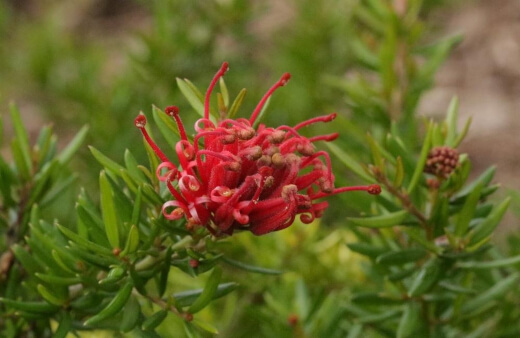
As mentioned earlier, this shrub looks right at home planted alongside other Australian native plants and flowers. Whether used as ground cover, as a feature plant or hung in large baskets outside, the Grevillea nudiflora shrub can fulfil many different applications and will look great planted in and around your garden.
Possible companion plants may include:
- Yellow Buttons
- Acacia Green Mist
Grevillea nudiflora Care Tips
Once established, these hardy shrubs will be tolerant to drought and frost. They are also very resistant to wind and salt from sea spray. They will not require too much hassle in terms of maintenance but there are a few care tips we can provide.
What Fertiliser to Use
Much like other grevilleas, the Nudiflora shrub is also very sensitive to phosphorus. Therefore, using a low phosphate fertiliser is vital.
Consider using a 13-2-13, a 14-0-14 or a special native blend fertiliser. Fertilising should only be done about once a year.
Watering Preference
Supplementary watering can be kept to a minimum so a light watering once a week is more than enough. If you are experiencing frequent rainfall then you can cut back on watering.
On the other hand, if you are experiencing very hot and dry weather, you can water the shrub twice a week perhaps. They are tolerant to some neglect so there’s no need to overthink it.
Pruning Grevillea nudiflora
The Grevillea nudiflora can tolerate light to hard pruning. You can perform light pruning on the shrub after the flowering season or cut back substantial amounts of foliage to encourage thicker growth.
Grevillea nudiflora Pests, Problems & Diseases

Being a tough and resistant shrub, there aren’t many issues or pests that this plant will struggle with normally. However, here are a few things you can look out for:
Phosphorus Toxicity
The Grevillea nudiflora shrub is sensitive to phosphorus. If you see that your foliage is turning yellow or scorching, this could indicate that the plants' phosphorus content is too high.
Stop using any fertiliser and soak the soil to try to leach any remaining phosphorus out of the ground. The shrub can recover from this.
Skin Irritant
In rare cases, the Grevillea nudiflora can cause skin irritation in children or people with sensitive skin. If you notice rashes starting to appear on the skin, avoid further contact with the shrub or remove it in severe cases.
Grevillea nudiflora Ground Cover FAQs
Do Grevilleas attract birds?
Grevilleas are known to be bird attracting plants. They are nectar-bearing plants that also carry seeds that attract a multitude of bird and insect life.
Are grevilleas hard to grow?
Grevilleas are low maintenance plants. They need well-draining soil and don’t like their roots to sit in wet soil. If drainage is an issue, you can raise the beds to improve the soil's moisture content between waterings.
Grevilleas, like many natives, do not respond well to being moved or transplanted.
Can grevilleas tolerate shade?
Yes, they can. Though growth may be stunted and blooms may be less impressive, they can grow in shaded locations. Ideally, full sun to partial shade is needed for a happy and healthy Grevillea.
Can't get enough of grevilleas? See the rest of our favourite varieties listed in our main Grevillea post.
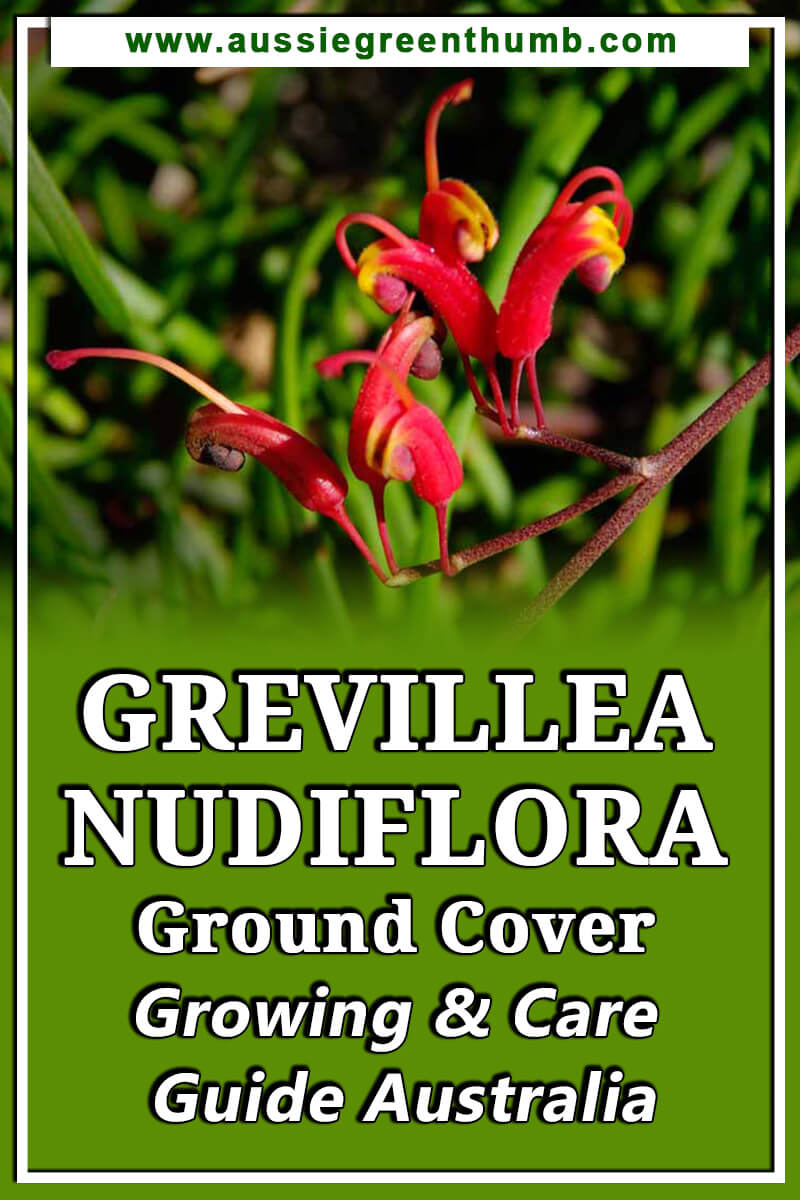
Introduce the Striking Beauty of Grevillea nudiflora to Your Garden
Being easy to grow and maintain, the Grevillea nudiflora shrub has many practical uses and works in a variety of gardening applications. An excellent choice for those who are looking at adding some native lusciousness to their gardens.
Glowing with red clusters of flowers atop trailing green foliage, the Grevillea nudiflora is a must-have for those who are fans of native plants.
Published on March 7, 2022 by Nathan Schwartz
Last Updated on February 26, 2024




